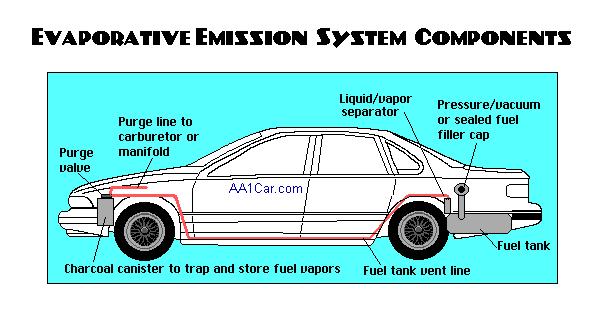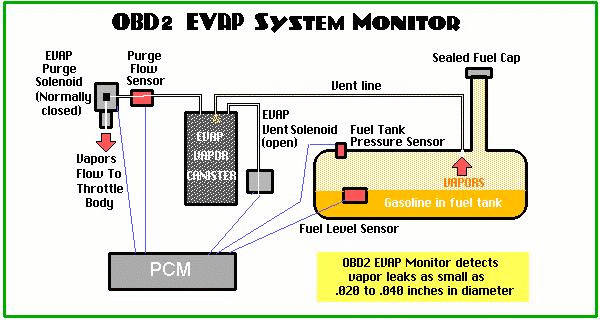Advertisement [ ? ]
Site Links
- Lease Calculator
- Advertise on 9,500+ pages
- My Car ongoing Review
- Members' Chat
- Cars For Sale
- Car Dealers
- Honda "Fit" Manual
- Hyperflex Bushings
- For Sale
- Fix your Car
- Car Manuals
- other manuals - Reference Materials
- DIY Repairs
- Articles
- Video
- Link with Us
- Search Help
- Code your Mac!
- Fly, race, anything R/C
- DIY repair guides
- Z-Seven
- Mechanic's Blog
- Free Files
EVAP Evaporative Emission Control System

The Evaporative Emission Control System (EVAP) is used to prevent gasoline vapors from escaping into the atmosphere from the fuel tank and fuel system.
The EVAP system usually requires no maintenance, but faults can turn on the Check Engine light and prevent a vehicle from passing an OBD II plug-in emissions test.
The OBD II EVAP monitor on 1996 and newer vehicles runs diagnostic self-checks to detect fuel vapor leaks, and if it finds any (including a loose or missing gas cap), it will set a fault code and turn on the Check Engine light. However, the EVAP monitor only runs under certain operating conditions. This may create a problem for the vehicle owner if his vehicle must be given an OBD II plug-in emissions test and the monitor has not completed.
Common problems with the EVAP system include faults with the purge valve that vents fuel vapors to the engine, leaks in vent and vacuum hoses, and loose, ill-fitting or missing gas caps. The most common fault code is P0440, which indicates a large leak (often a loose gas cap). EVAP Purge valve codes (P0443 to P0449) are also common).
The code you dont want to see is a P0442. This indicates the system has detected a SMALL leak, but small leaks can often be a BIG problem to find. By small, we mean a leak no larger than a pin prick! Such small leaks are virtually impossible to find visually, so a special tester called a smoke machine is usually necessary to reveal the leak. The smoke machine feeds a mineral-oil based vapor into the EVAP system under light pressure (no more than a few pounds per square inch). The smoke may also contain an ultraviolet dye to make it easier to see under UV light.
Fixing EVAP codes can be a challenge, even for professional technicians. And if you have a P0442 small leak code, youll probably have to take your car to a repair shop that has a smoke machine.
WHY EVAP?
The EPA requires EVAP systems on cars because gasoline fuel vapors contain a variety of different hydrocarbons (HC). The lighter elements in gasoline evaporate easily, especially in warm weather. These include aldehydes, aromatics, olefins, and higher paraffins. These substances react with air and sunlight (called a photochemical reaction) to form smog. Aldehydes are
often called instant smog because they can form smog without undergoing photochemical changes.
The bad thing about fuel vapors is that fuel evaporates any time there is fuel in the tank. That means if the fuel system is unsealed or open to the atmosphere, it can pollute 24 hours a day even if the vehicle is not being driven. Uncontrolled evaporative emissions like this can account for as much as 20 percent of the pollution produced by a motor vehicle.
The EVAP system totally eliminates fuel vapors as a source of air pollution by
sealing off the fuel system from the atmosphere. Vent lines from the fuel tank and carburetor bowl route vapors to the EVAP storage canister, where they are trapped and stored until the engine is started. When the engine is warm and the vehicle is going down the road, the PCM then opens a purge valve allowing the vapors to be siphoned from the storage canister into the intake manifold. The fuel vapors are hen burned in the engine.
Evaporative emission controls were first required on cars sold in California in 1970. EVAP has been used on all cars and light trucks since the early 1970s.
HOW THE EVAPORATIVE EMISSION CONTROL SYSTEM WORKS
Sealing the fuel tank is not as simple as it sounds. For one thing, a fuel tank must have some type of venting so air can enter to replace fuel as the fuel is sucked up the fuel pump and sent to the engine. If the tank were sealed tight, the fuel pump would soon create enough negative suction pressure inside the tank to collapse the tank. On older EVAP systems, the tank is vented by a spring-loaded valve inside the gas cap. On newer vehicles, it is vented through the EVAP canister.
EVAP SYSTEM COMPONENTS
The major components of the evaporative emission control
system include:
Some liquid-vapor separators use a slightly different approach to keeping liquid fuel out of the canister vent line. A float and needle assembly is mounted inside the separator. If liquid enters the unit, the float rises and seats the needle valve to close the tank vent.
Another approach sometimes used is a foam-filled dome in the top of the fuel tank. Vapor will pass through the foam but liquid will cling to the foam and drip.
If a blockage occurs in the liquid-vapor separator or in the vent line between it and the EVAP canister, the fuel tank will not be able to breathe properly. Symptoms include fuel starvation or a collapsed fuel tank on vehicles with solid-type gas caps. If you notice a whoosh of pressure in or out of the tank when the gas gap is removed, suspect poor venting. You can check tank venting by removing the gas cap and then disconnecting the gas tank vent line from the EVAP canister. If the system is free and clear, you should be able to blow through the vent line into the fuel tank. Blowing with compressed air can sometimes free a blockage. If not, you will have to inspect the vent line and possibly remove the fuel tank to diagnose the problem.
The most common problem with the EVAP canister is a faulty purge control or vent solenoid. Vacuum-type purge valves can be tested by applying vacuum directly to the purge valve with a hand-held vacuum pump. The valve should open and not leak vacuum if it is good. With solenoid-type purge valves, voltage can applied directly to the solenoid to see if the valve opens. The resistance of the solenoid can also be checked with an ohmmeter to see if it is open or shorted.
The purge control strategy on many late model EVAP systems can get rather complicated, so the best advice here is to look up the EVAP diagnostic procedures in the OEM service literature or on Alldata.

EVAPORATIVE EMISSIONS & OBD2
On 1996 and newer vehicles,
the OBD2 system monitors the fuel system for fuel vapor leaks to make sure no hydrocarbons are escaping into the atmosphere. The EVAP monitor does two things: it verifies there is airflow from the EVAP canister to the engine, and that there are no leaks in the fuel tank, EVAP canister or fuel system vapor lines.The OBD2 EVAP monitor runs once per drive cycle and only when the fuel tank is 15 to 85% full. The EVAP monitor uses a "purge flow sensor" to detect leaks as small as .040 inches in diameter on 1996-99 models, and as small as .020 inches on most 2000 and newer vehicles.
If OBD2 detects a leak when it runs the EVAP leak check, it will set a fault code in the P0440 to P0457 range.
If you find a P0440 fault code (large fuel vapor leak), remvoe the gas cap, inspect the seal on the filler tank inlet and the underside of the gas cap for any nicks, debris or damage. Then screw the gas cap back on and make sure it clicks at least once to assure a tight seal. If a fuel vapor leak at the gas cap set the P0440 code, the fault should clear and the Check Engine light go out the next time the EVAP monitor runs. If the light stays on, the problem is either a bad gas cap or a large vapor leak somewhere in the EVAP system (most likely a leaky or loose vapor hose).
Back to Driveability Diagnostics Emissions | Back to Info Main Page
Total messages: 0

